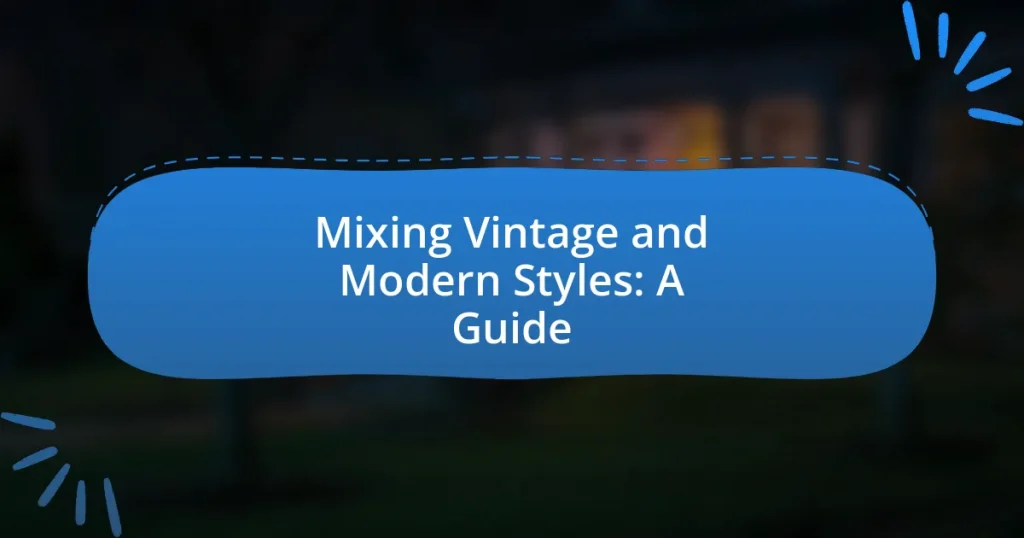Mixing vintage and modern styles involves combining elements from different historical periods with contemporary design to create a cohesive aesthetic. This article explores how blending these styles enhances interior design by fostering individuality and emotional connections. Key characteristics of vintage styles, such as unique patterns and rich textures, are contrasted with modern design principles that emphasize minimalism and functionality. The article also outlines best practices for achieving balance, selecting color palettes, and avoiding common mistakes when integrating these styles, while providing practical tips for curating a collection of vintage and modern pieces. Additionally, it highlights the cultural influences driving this trend and the role of accessories and decor in bridging the gap between the two styles.

What does it mean to mix vintage and modern styles?
Mixing vintage and modern styles means combining elements from different historical periods with contemporary design to create a cohesive aesthetic. This approach allows individuals to express their unique tastes by integrating classic pieces, such as furniture or decor from previous decades, with modern items that reflect current trends. The effectiveness of this mix often relies on balancing the old and new, ensuring that the overall look feels harmonious rather than disjointed. For example, pairing a mid-century modern chair with a sleek, contemporary table can create an inviting and stylish space that showcases both eras.
How can blending these styles enhance interior design?
Blending vintage and modern styles enhances interior design by creating a dynamic and visually interesting space that reflects both nostalgia and contemporary aesthetics. This combination allows for the incorporation of unique, character-rich vintage pieces alongside sleek, functional modern elements, resulting in a balanced and harmonious environment. Research indicates that such eclectic designs can evoke emotional responses and foster a sense of individuality, as seen in studies on consumer preferences in interior design. By merging these styles, designers can cater to diverse tastes while maximizing the functionality and appeal of a space.
What are the key characteristics of vintage styles?
Vintage styles are characterized by their nostalgic elements, often reflecting design trends from previous decades, typically ranging from the 1920s to the 1980s. These styles frequently feature unique patterns, rich textures, and classic silhouettes that evoke a sense of history and craftsmanship. For instance, vintage clothing often includes high-waisted trousers, A-line dresses, and tailored blazers, which were popular in mid-20th century fashion. Additionally, vintage decor may showcase ornate furniture, retro color palettes, and decorative motifs that highlight the aesthetics of the time period. The appeal of vintage styles lies in their ability to blend timeless elegance with individuality, making them a favored choice for those seeking to create distinctive and personalized environments.
What defines modern styles in design?
Modern styles in design are characterized by minimalism, functionality, and the use of new materials and technologies. This approach emphasizes clean lines, open spaces, and a lack of ornamentation, which reflects the principles established in the early 20th century by movements such as Bauhaus and Mid-Century Modern. The integration of sustainable materials and smart technology further defines modern design, aligning with contemporary values of environmental consciousness and efficiency.
Why is mixing vintage and modern styles popular?
Mixing vintage and modern styles is popular because it creates a unique aesthetic that combines nostalgia with contemporary design elements. This blending allows individuals to express their personal style while incorporating pieces that have historical significance or character. The trend is supported by the rise of sustainable fashion and interior design, where repurposing vintage items reduces waste and promotes environmental consciousness. Additionally, surveys indicate that consumers increasingly seek individuality in their spaces, with 70% of millennials favoring eclectic styles that reflect their diverse tastes.
How does this mix reflect personal identity?
The mix of vintage and modern styles reflects personal identity by showcasing individual preferences and values in aesthetic choices. This combination allows individuals to express their unique tastes, blending nostalgia with contemporary trends, which can signify a connection to the past while embracing the present. For instance, incorporating vintage pieces can indicate an appreciation for history and craftsmanship, while modern elements may reflect a desire for innovation and current relevance. This duality in style not only personalizes living spaces but also communicates a narrative about the individual’s journey, interests, and cultural influences.
What cultural influences contribute to this trend?
Cultural influences contributing to the trend of mixing vintage and modern styles include nostalgia for past aesthetics, the rise of sustainability in fashion, and the impact of social media. Nostalgia drives individuals to seek out vintage pieces that evoke memories or represent a specific era, such as the 1960s or 1980s, which are often celebrated for their unique styles. The sustainability movement encourages consumers to repurpose and incorporate vintage items into their wardrobes, reducing waste and promoting eco-friendly practices. Additionally, social media platforms like Instagram and Pinterest showcase diverse fashion combinations, inspiring users to blend different styles and eras creatively. This combination of nostalgia, sustainability, and social media influence solidifies the trend of mixing vintage and modern styles in contemporary fashion.

What are the best practices for mixing vintage and modern styles?
The best practices for mixing vintage and modern styles include selecting a cohesive color palette, balancing proportions, and incorporating statement pieces. A cohesive color palette ensures that both vintage and modern elements complement each other, creating a harmonious look. Balancing proportions involves mixing larger vintage furniture with sleek modern pieces to avoid overwhelming the space. Incorporating statement pieces, such as a bold vintage artwork or a contemporary sculpture, can serve as focal points that tie the two styles together. These practices are supported by design principles that emphasize harmony and contrast, making the combination visually appealing and functional.
How can one achieve balance between vintage and modern elements?
To achieve balance between vintage and modern elements, one should strategically combine pieces from both styles to create a cohesive look. This can be accomplished by selecting a dominant style, such as modern, and incorporating vintage accents that complement it, ensuring that the overall aesthetic remains harmonious. For instance, pairing a contemporary sofa with vintage accessories like an antique lamp or artwork can create visual interest without overwhelming the space. Research indicates that blending styles can enhance the emotional appeal of a space, as seen in studies on interior design preferences, which show that a mix of old and new can evoke nostalgia while maintaining a fresh feel.
What color palettes work best for this combination?
The best color palettes for mixing vintage and modern styles include muted tones paired with bold accents. For instance, a combination of soft pastels like blush pink or mint green can be effectively contrasted with vibrant colors such as deep navy or rich mustard. This approach allows the vintage elements to maintain their charm while the modern accents add a contemporary flair. Research indicates that color theory supports the use of complementary colors to create visual interest, enhancing the overall aesthetic appeal of the space.
How can furniture selection impact the overall aesthetic?
Furniture selection significantly impacts the overall aesthetic by influencing the visual harmony and style of a space. The choice of materials, colors, and designs can either complement or clash with existing decor, thereby shaping the ambiance. For instance, modern furniture often features clean lines and minimalistic designs, which can create a sleek, contemporary look, while vintage pieces may introduce warmth and character through intricate details and rich textures. Research indicates that the combination of different styles, such as vintage and modern, can enhance visual interest and create a unique aesthetic, as seen in interior design trends that emphasize eclecticism.
What common mistakes should be avoided when mixing styles?
When mixing styles, common mistakes to avoid include failing to establish a cohesive color palette, which can lead to visual disarray. A well-defined color scheme ensures that vintage and modern elements complement rather than clash. Additionally, neglecting scale and proportion can result in an unbalanced look; for instance, pairing oversized vintage furniture with sleek modern pieces without considering their relative sizes can disrupt harmony. Lastly, overlooking the importance of texture can create a flat aesthetic; incorporating various materials, such as wood, metal, and fabric, enhances depth and interest in the design.
How can over-cluttering affect the design outcome?
Over-cluttering negatively impacts the design outcome by creating visual chaos that distracts from the intended aesthetic. When a space is overloaded with items, it becomes difficult for the viewer to focus on key design elements, leading to a lack of coherence and harmony. Research indicates that environments with excessive clutter can increase cognitive load, making it harder for individuals to process information and appreciate the design (S. H. K. Lee et al., “The Effects of Clutter on Cognitive Load,” Journal of Environmental Psychology, 2020). This cognitive overload can diminish the overall effectiveness of a design, particularly when mixing vintage and modern styles, as the unique characteristics of each style may become lost amidst the clutter.
What role does scale and proportion play in successful mixing?
Scale and proportion are crucial in successful mixing as they determine the visual and auditory balance between vintage and modern elements. Proper scale ensures that the size of each component complements the overall design, preventing any single element from overwhelming the others. For instance, a large vintage piece can dominate a space if not paired with appropriately scaled modern elements, leading to a disjointed aesthetic. Proportion, on the other hand, relates to the relationship between different elements, ensuring harmony and cohesion. When vintage and modern styles are proportionately balanced, they create a unified look that feels intentional rather than chaotic. This principle is supported by design theories that emphasize the importance of balance in aesthetic appeal, such as the Golden Ratio, which has been used in art and architecture for centuries to achieve visual harmony.

What specific tips can help in successfully mixing vintage and modern styles?
To successfully mix vintage and modern styles, focus on creating a balanced aesthetic by selecting key pieces from both eras that complement each other. For instance, pairing a modern sofa with vintage accent chairs can create visual interest while maintaining harmony. Additionally, using a cohesive color palette that incorporates both vintage and modern hues can unify the space. According to design experts, blending textures, such as a sleek modern table with a rustic vintage rug, enhances depth and character in the design. This approach not only showcases the uniqueness of each style but also fosters a cohesive environment.
How can accessories enhance the vintage-modern blend?
Accessories can enhance the vintage-modern blend by serving as focal points that bridge the two styles. For instance, a vintage brooch can add a touch of nostalgia to a contemporary outfit, while modern geometric earrings can provide a fresh contrast to a classic dress. This interplay not only creates visual interest but also allows for personal expression, as accessories can reflect individual tastes and preferences. Historical trends show that integrating accessories from different eras can elevate an outfit’s overall aesthetic, making it more dynamic and appealing.
What types of decor items are most effective in this mix?
Effective decor items in mixing vintage and modern styles include statement furniture pieces, such as a mid-century modern chair paired with a contemporary coffee table, and art that bridges both eras, like abstract paintings alongside vintage frames. These items create a cohesive aesthetic by combining contrasting elements that complement each other. For instance, a vintage rug can ground a modern space, while modern lighting fixtures can add a fresh touch to vintage furnishings. This approach is supported by design principles that emphasize balance and harmony, allowing for a visually appealing integration of styles.
How can art pieces bridge the gap between styles?
Art pieces can bridge the gap between styles by incorporating elements from both vintage and modern aesthetics, creating a cohesive visual dialogue. For instance, a contemporary artwork that utilizes traditional techniques or motifs can resonate with viewers who appreciate historical context while appealing to modern sensibilities. This blending is evident in the works of artists like Kehinde Wiley, who combines classical portraiture with contemporary themes, thereby merging different artistic eras. Such integration not only fosters appreciation across diverse styles but also encourages innovative interpretations, making art more accessible and relatable to a broader audience.
What are some practical steps to start mixing these styles in your home?
To start mixing vintage and modern styles in your home, begin by selecting a color palette that harmonizes both styles, such as neutral tones with pops of color. This approach allows for a cohesive look while integrating various elements. Next, incorporate key vintage pieces, like furniture or decor, alongside modern items to create contrast and interest. For example, pairing a mid-century modern chair with a contemporary coffee table can establish a balanced aesthetic. Additionally, use accessories, such as artwork or textiles, to blend the two styles; vintage frames can showcase modern art effectively. Finally, ensure that the layout promotes flow and functionality, allowing each piece to complement the others without overwhelming the space.
How can one curate a collection of vintage and modern pieces?
To curate a collection of vintage and modern pieces, one should first identify a cohesive theme that blends both styles, such as color schemes or design elements. This approach allows for a harmonious integration of items from different eras. Researching reputable sources, such as design blogs or vintage marketplaces, can provide insights into current trends and valuable pieces. Additionally, attending estate sales, flea markets, and auctions can yield unique finds that complement modern items. The combination of these strategies ensures a well-rounded collection that reflects personal taste while maintaining aesthetic balance.
What resources are available for inspiration and guidance?
Resources available for inspiration and guidance in mixing vintage and modern styles include design blogs, social media platforms, and interior design books. Design blogs such as Apartment Therapy and Design*Sponge provide curated content showcasing successful blends of styles, while platforms like Pinterest and Instagram offer visual inspiration through user-generated content. Additionally, books like “The New Bohemians” by Justina Blakeney and “Mid-Century Modern: Interiors, Furniture, Design Details” by Bradley Quinn provide in-depth insights and examples of integrating vintage and modern aesthetics. These resources collectively offer practical ideas and visual references for achieving a harmonious design.


